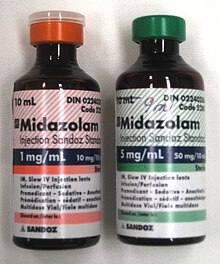Midazolam

Midazolam is a drug. It is used as a sedative, it calms people down. It is also used as an anesthetic. It will make people sleepy. It also causes anterograde amnesia[1] In some parts of the world it is known as Versed.
Midazolam is a benzodiazepine. This means that people will get addicted to it, if they take it for a longer period of time.
The drug does not make people to become unconscious, it only sedates them.[1] Midazolam is also used to treat long-lasting seizures.[2] Most often, a seizure is short. Midazolam is available in different forms; there are tablets to be taken by mouth, there is a solution that can be injected, and there are ways to allow to give it anally. There's also a spray. When it is injected, it usually starts working within as little as five minutes. Effects last between one and six hours.
Side effects include a decrease in efforts to breathe, low blood pressure, and sleepiness.[1] Tolerance to its effects and withdrawal syndrome may occur after long-term use.[3] Paradoxical effects, such as increased activity, can occur especially in children and older people.[3] There is evidence of risk when used during pregnancy but no evidence of harm with a single dose during breastfeeding.[4][5] Like other benzodiazepines, it works by increasing the activity of the GABA neurotransmitter in the brain.
Midazolam was patented in 1974 and came into medical use in 1982.[6] It is on the World Health Organization's List of Essential Medicines.[7] Midazolam is available as a generic medication.[4]In many countries, it is a controlled substance.[1] This means that a medical prescription is required to get it.
In the past, midazolam has been used for the following:
- Acute management of longer epileptic seizures, including status epilepticus.
- As a sedative for someone before a medical intervewntion (usually combined with an opioid such as fentanyl)
- To manage agitation in diseases such as Schizophrenia, usually combined with an antipsychotic.
- End-of-life care
References[change | change source]
- ↑ 1.0 1.1 1.2 1.3 "Midazolam Hydrochloride". The American Society of Health-System Pharmacists. Archived from the original on 5 September 2015. Retrieved 1 August 2015.
- ↑ Brigo F, Nardone R, Tezzon F, Trinka E (August 2015). "Nonintravenous midazolam versus intravenous or rectal diazepam for the treatment of early status epilepticus: A systematic review with meta-analysis". Epilepsy & Behavior. 49: 325–336. doi:10.1016/j.yebeh.2015.02.030. PMID 25817929.
- ↑ 3.0 3.1 Riss J, Cloyd J, Gates J, Collins S (August 2008). "Benzodiazepines in epilepsy: pharmacology and pharmacokinetics". Acta Neurologica Scandinavica. 118 (2): 69–86. doi:10.1111/j.1600-0404.2008.01004.x. PMID 18384456.
- ↑ 4.0 4.1 Hamilton R (2015). Tarascon Pocket Pharmacopoeia 2015 Deluxe Lab-Coat Edition. Jones & Bartlett Learning. p. 21. ISBN 9781284057560.
- ↑ "Midazolam use while Breastfeeding". Archived from the original on 5 September 2015. Retrieved 29 August 2015.
- ↑ Fischer J, Ganellin CR (2006). Analogue-based Drug Discovery. John Wiley & Sons. p. 539. ISBN 9783527607495. Archived from the original on 30 November 2021. Retrieved 24 August 2020.
- ↑ World Health Organization (2021). World Health Organization model list of essential medicines: 22nd list (2021). Geneva: World Health Organization. hdl:10665/345533. WHO/MHP/HPS/EML/2021.02.
